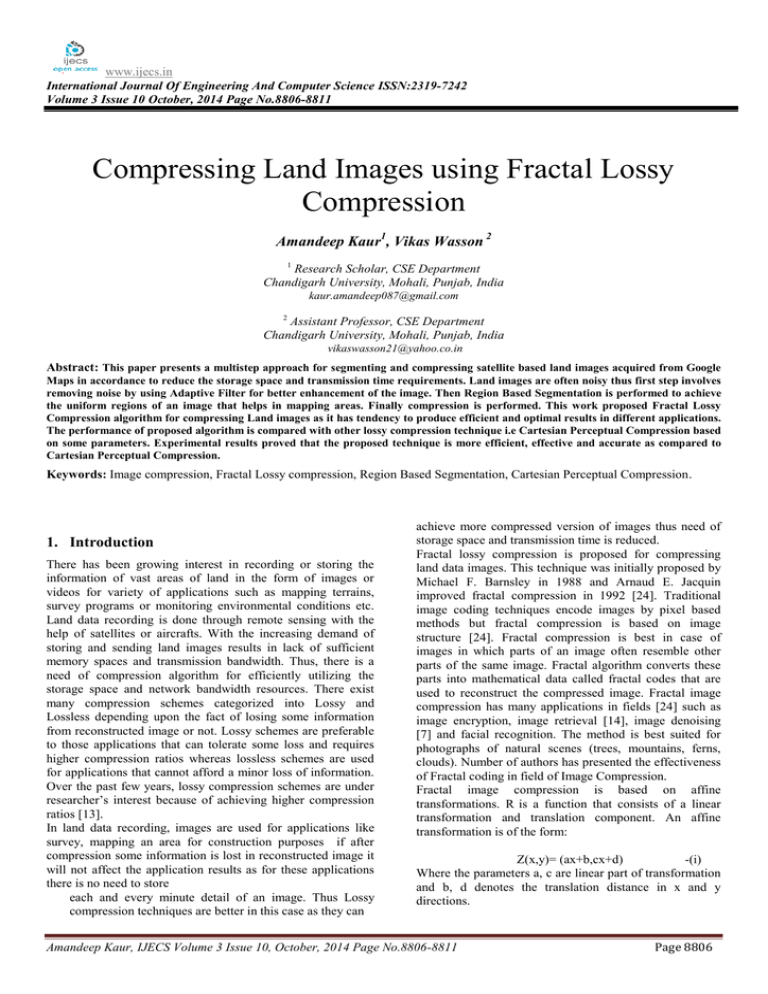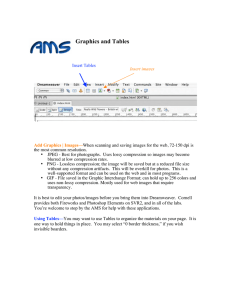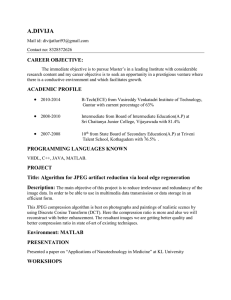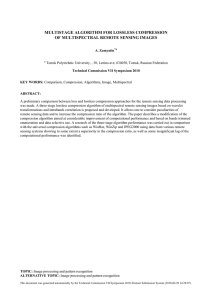www.ijecs.in International Journal Of Engineering And Computer Science ISSN:2319-7242
advertisement

www.ijecs.in
International Journal Of Engineering And Computer Science ISSN:2319-7242
Volume 3 Issue 10 October, 2014 Page No.8806-8811
Compressing Land Images using Fractal Lossy
Compression
Amandeep Kaur1, Vikas Wasson 2
1
Research Scholar, CSE Department
Chandigarh University, Mohali, Punjab, India
kaur.amandeep087@gmail.com
2
Assistant Professor, CSE Department
Chandigarh University, Mohali, Punjab, India
vikaswasson21@yahoo.co.in
Abstract: This paper presents a multistep approach for segmenting and compressing satellite based land images acquired from Google
Maps in accordance to reduce the storage space and transmission time requirements. Land images are often noisy thus first step involves
removing noise by using Adaptive Filter for better enhancement of the image. Then Region Based Segmentation is performed to achieve
the uniform regions of an image that helps in mapping areas. Finally compression is performed. This work proposed Fractal Lossy
Compression algorithm for compressing Land images as it has tendency to produce efficient and optimal results in different applications.
The performance of proposed algorithm is compared with other lossy compression technique i.e Cartesian Perceptual Compression based
on some parameters. Experimental results proved that the proposed technique is more efficient, effective and accurate as compared to
Cartesian Perceptual Compression.
Keywords: Image compression, Fractal Lossy compression, Region Based Segmentation, Cartesian Perceptual Compression.
1. Introduction
There has been growing interest in recording or storing the
information of vast areas of land in the form of images or
videos for variety of applications such as mapping terrains,
survey programs or monitoring environmental conditions etc.
Land data recording is done through remote sensing with the
help of satellites or aircrafts. With the increasing demand of
storing and sending land images results in lack of sufficient
memory spaces and transmission bandwidth. Thus, there is a
need of compression algorithm for efficiently utilizing the
storage space and network bandwidth resources. There exist
many compression schemes categorized into Lossy and
Lossless depending upon the fact of losing some information
from reconstructed image or not. Lossy schemes are preferable
to those applications that can tolerate some loss and requires
higher compression ratios whereas lossless schemes are used
for applications that cannot afford a minor loss of information.
Over the past few years, lossy compression schemes are under
researcher’s interest because of achieving higher compression
ratios [13].
In land data recording, images are used for applications like
survey, mapping an area for construction purposes if after
compression some information is lost in reconstructed image it
will not affect the application results as for these applications
there is no need to store
each and every minute detail of an image. Thus Lossy
compression techniques are better in this case as they can
achieve more compressed version of images thus need of
storage space and transmission time is reduced.
Fractal lossy compression is proposed for compressing
land data images. This technique was initially proposed by
Michael F. Barnsley in 1988 and Arnaud E. Jacquin
improved fractal compression in 1992 [24]. Traditional
image coding techniques encode images by pixel based
methods but fractal compression is based on image
structure [24]. Fractal compression is best in case of
images in which parts of an image often resemble other
parts of the same image. Fractal algorithm converts these
parts into mathematical data called fractal codes that are
used to reconstruct the compressed image. Fractal image
compression has many applications in fields [24] such as
image encryption, image retrieval [14], image denoising
[7] and facial recognition. The method is best suited for
photographs of natural scenes (trees, mountains, ferns,
clouds). Number of authors has presented the effectiveness
of Fractal coding in field of Image Compression.
Fractal image compression is based on affine
transformations. R is a function that consists of a linear
transformation and translation component. An affine
transformation is of the form:
Z(x,y)= (ax+b,cx+d)
-(i)
Where the parameters a, c are linear part of transformation
and b, d denotes the translation distance in x and y
directions.
Amandeep Kaur, IJECS Volume 3 Issue 10, October, 2014 Page No.8806-8811
Page 8806
Let we have a finite collection of contractive affine maps
Z1, Z2,...,Zn that forms an Iterated functions system(IFS).
If B is a nonempty subset of R, then the map
Z(B) = U Zi(B)
-(ii)
is a contractive map on H, the (complete) metric space of
compact sets in R. If Z has a unique fixed point A in H.
Then A is said to be compact subset of R and also termed
as the attractor of Z.
The rest of this paper is structured as follows. Section
II describes the steps of proposed methodology. Further
Section III explains the results and discussions based on
experiments performed. Finally, the conclusions and
future scope is discussed in Section IV.
2.
Proposed Methodology
The following are the proposed steps for efficiently recording
of land images.
1. Samples images are acquired from Google Maps.
2. Pre-processing of sample images by using Adaptive
filter for better enhancement of images.
3. Applying Region Based Segmentation to find the
uniform regions of an image.
4. Data Size Reduction using Fractal Lossy Compression.
5. Comparing the results of Proposed Compression
algorithm with Cartesian Perceptual compression
based on performance parameters.
Acquire sample land images from Google
Maps
Noise removal using adaptive filter for better
enhancement of an image
Applying Region Based Segmentation to find
the uniform regions of an image
Data Size Reduction using Fractal Lossy
Compression
Compressed Image
Figure 1: Proposed Methodology
A. Acquire an input image and Preprocessing
Initially Sample land images are collected from Google Maps.
First step is to resize the images to 400*180 for making the
further processing easier. Land images are often deterioted due
to the presence of noise. Next step is to preprocess the sample
images by using Noise Removal filter. Thus Noise is removed
by using adaptive filter.
B. Applying Region Based Segmentation
Segmentation of the land image based on Region of Interest is
performed. Partitioning of the image is performed to extract the
uniform patterns in the image to decide to which terrain they
belong using Region Based Segmentation based on Threshold
value. Input Land image is partitioned into 3 uniform segments
that are Urban Area including houses and buildings, Roads and
Forests based on gray level values of the pixels in an image.
These segments help in mapping an area.
C. Fractal Lossy Compression
Fractal image compression is a compression technique that
depends on similarities of an image structure. It is mentioned in
literature that small amount of noise is suppressed from an
image if noisy image is simply fractally coded [7].
Algorithm of Fractal coding:
1. Divide the image into N non-overlapping parent blocks
(PB)-{1,2,…N}.
2. Then divide each parent block into 4 child blocks (CB).
3. Compare each PB with its child block to find the
closest match.
4. When PB is found similar to any child block then
apply affine transformation.
5. Then store the location of parent block, transform
component and related child block.
6. Repeat above written steps for each parent block to
achieve compression.
7. Apply the stored information to blank image of the
same size as original image to get reconstructed
image.
D. Comparison of results/performance with some other
compression technique
The results of Fractal Compression algorithm are compared
with Cartesian Perceptual Compression technique based on
parameters such as Mean Square Error, Root Mean Square
Error, Peak Signal to Noise Ratio and CPU Processing Time.
These parameters are described briefly:
1. Mean Square Error (MSE): It is the difference between the
compressed image and original image. It checks the error
occurred in the image after applying compression.
- (iii)
where M and N denotes the number of rows and columns in
the images and P and Q are original image and reconstructed
image after compression respectively.
2. Root Mean Square Error (RMSE) is smaller, the
performance is better. It is computed by using following
equation:
- (iv)
3. Peak Signal to Noise Ratio (PSNR): This parameter
measures the peak error between the compressed image and
original image. Thus, for better results the value of this
parameter must be high which denotes the better image quality.
The PSNR is computed from following equation:
- (v)
where MAXi is the maximum possible pixel value of an image
and this value is taken as 255.
Amandeep Kaur, IJECS Volume 3 Issue 10, October, 2014 Page No.8806-8811
Page 8807
4. CPU Processing Time: It calculates the time taken by an
algorithm to compress and reconstruct the image. Hence, for
better results this parameter value must be small. It checks the
efficiency of algorithm that how fast that can complete its task.
5. Image Size: It calculates the size of an image before and
after compression. This parameter value depends on the
compression ratio, higher the compression ratio smaller will be
image size.
3. Results and Discussions
(f) Forests
(e) Roads
This section presents the results obtained on land images. The
screenshots and tabular results are presented in this section. For
better understanding, the comparison results are also presented
in Graphical form. The Proposed work is implemented in
Matlab.
A. Screenshot Results
In below figure , (a) presents the original land image taken
from Google Maps, (b) presents the image after converting to
Grayscale, (c) presents the denoised image after applying
adaptive filter, (d) presents the urban area of an image by white
color ,(e) shows the roads of an image with white color and
black color shows the area of rest of the image,(f) shows the
forests with white color and black color denotes the rest of the
regions of an image.
(g) Fractal Compression
(h) CPC
Figure 2: Screenshot results on sample land image.
B. Comparison Table
Table 1: Comparison Results of Proposed Fractal Compression with
Cartesian Perceptual Compression
Parameters
Fractal
Cartesian
Compression
Perceptual
Compression
(a) Original Image
(b) Grayscale Image
CR
16
9.1755
MSE
0.86057
0.89844
RMSE
0.92767
0.94786
PSNR
48.7829
48.5959
Image Size
4.3945
7.6631
CPU Time ( in
131.26
230.13
milliseconds)
C. Comparison Graphs
(c) Denoised Image
(d) Urban Area
Amandeep Kaur, IJECS Volume 3 Issue 10, October, 2014 Page No.8806-8811
Page 8808
Figure 3: Comparison of Proposed Fractal Compression with
CPC (Parameter CR)
Figure 6: Comparison of Proposed Fractal Compression with
CPC (Parameter PSNR)
Figure 4: Comparison of Proposed Fractal Compression with
CPC (Parameter MSE)
Figure 7: Comparison of Proposed Fractal Compression with
CPC (Parameter CPU Time)
Figure 5: Comparison of Proposed Fractal Compression with
CPC (Parameter RMSE)
Figure 8: Comparison of Proposed Fractal Compression with
CPC (Parameter Image Size)
4. Conclusions and Future Scope
A.Conclusions
Image compression finds its important role in
telecommunication applications such as video conferences etc.
Land images take a huge amount of memory thus image
Amandeep Kaur, IJECS Volume 3 Issue 10, October, 2014 Page No.8806-8811
Page 8809
compression is required to minimize the storage
requirements.The increasing interest in image compression has
led to the development of many new compression techniques.
Experiments are carried out to compress the different Land
images with both algorithms and the results show the proposed
algorithm is faster and leads to improve the rate distortion
performance as compare to existing algorithm.
As the proposed technique falls in lossy compression category,
it can be useful for compressing land images where small
amount of information loss can be tolerable.
B. Future Scope
Presently human interaction is required to run the code but in
future full automation can be possible. This work compress
images of land but in future my work extends to compressing
videos of vast land areas.
Experimental results demonstrated that introducing Fractal
Image Compression algorithm in other applications has great
future in improving the compression performance. Still, huge
amount of research is going on Image Compression Techniques
and there is lot of scope to contribute in this domain by new
researchers.
References
[1] Belloulata, K., & Konrad, J., “Fractal Image Compression
With Region-Based Functionality”, IEEE Transactions
on Image Processing, vol. 11, no. 4, Apr. 2002.
[2] Bernstein, R., Lotspoech, J. B., Myers, H. J., Kolsky, H. G.,
& Lees, R. D. , “Analysis and processing of Landsat-4
sensor data using advanced image processing techniques
and technologies”, IEEE Transactions on Geoscience and
Remote Sensing ,vol 22, no. 3, May 1984.
[3] Cagnazzo, M., Poggi, G., Verdoliva, L., & Zinicola, A.,
“Region-oriented compression of
multispectral images by shape- adaptive
wavelet transform and SPIHT ” , IEEE
International
Conference
on
Image
Processing, vol. 4, Oct. 2004.
[4] Cremers, D., Rousson, M., & Deriche , R., “A Review
of
Statistical
Approaches
to
Level
Set
Segmentation : Integrating Color,
Texture, Motion
and Shape”,
Springer International Journal of
Computer Vision, vol. 72, pp no. 195–215, Aug.
2006.
[5] Douak, F., Benzid, R., & Benoudjit, N., “Color image
compression algorithm based on the DCT transform
combined to an adaptive block scanning”, Elsevier AEUInternational
Journal
of
Electronics
and
Communications, vol.65, pp no.16-26, Apr. 2011.
[6] Gleich, D., Planinsic, P., Gergic, B., & Cucej, Z.,
"Progressive space frequency quantization for SAR data
compression”, IEEE Transactions on Geoscience and
Remote Sensing, vol. 40, no. 1, Jan. 2002.
[7] Ghazel, M., Freeman, G.H., & Vrscay, E.R., "Fractal image
denoising”, IEEE Transactions on Image Processing vol.
12, no. 12, Dec. 2003.
[8] Hagenlocher, M., Lang, S., Holbling, D., Tiede, D., &
Kienberger, S., "Modeling hotspots of climate change in
the Sahel using object-based
regionalization
of
multidimensional gridded datasets ", IEEE Journal of
selected topics in Applied Earth Observations and
Remote Sensing, vol. 7, no. 1, Jan. 2014.
[9] Hou, P., Petrou, M., Underwood, C. I., & Hojjatoleslami,
A., “Improving JPEG performance in conjunction with
cloud editing for remote sensing applications”, IEEE
Transactions on Geoscience and Remote Sensing, vol. 38,
no.1, Jan. 2000.
[10] Mamun, M., Jia, X., & Ryan, M.J., "Nonlinear Elastic
Model for Flexible Prediction of Remotely Sensed
Multitemporal Images" IEEE Geoscience and Remote
Sensing Letters, vol. 11, no.5, May 2014.
[11] Ming, L., Jang-Feng Lee, G. E. Jan, “A Lossless Data
Compression and Decompression Algorithm and
It’s Hardware Architecture ” IEEE Transaction on
VLSI, vol. 14 ,2006.
[12] Nelson, J., Ames, A., Williams, J., Patschke, R., Mott, C.,
Joseph, J., Garon, H., & Mah, G., “Landsat Data
Continuity Mission (LDCM) space to ground mission
data architecture” IEEE in Aerospace Conference, pp.
1-13, Mar. 2012.
[13] Penna, B., Tillo, T., Magli, E., & Olmo, G., “Transform
Coding Techniques for Lossy Hyperspectral Data
Compression”, IEEE Transactions on Geoscience and
Remote Sensing, vol. 45, no.5, May 2007.
[14] Pi, M., Mandal, M.K., & Basu, A., “Image Retrieval
Based on Histogram of Fractal Parameters”, IEEE
Transactions on Multimedia, vol. 7, no. 4, Aug. 2005.
[15] Ponomarenko, N. N., Lukin, V.V., Zriakhov, M.S.,
Kaarna, A., & Astola, J., "Automatic approaches to onland/on-board filtering and lossy compression of AVIRIS
images" , IEEE International in Geoscience and Remote
Sensing Symposium, vol. 3, pp no.254-257 , 2008.
[16] Rafael C. Gonzalez, Richard E.Woods; “ Digital
Image Processing”, Edition 3, 2011.
[17] Shimabukuro, Y. E., Duarte, V., Arai, E., Freitas, R.M.,
Martini, P.R., & Lima, A., "Mapping and monitoring land
cover in Acre State, Brazilian Amazonia, using
Multitemporal remote sensing data." IEEE International
in Geoscience and Remote Sensing Symposium, vol. 4,
pp no. 242-248, 2009.
[18] Sobrino, J.A., Julien, Y., & Soria, G., “Phenology
Estimation From Meteosat Second Generation Data”,
IEEE Journal of selected topics in Applied Earth
Observations and Remote Sensing, vol. 6, no. 3, June
2013.
[19] Stamm, M. C., & Liu, K. R., “Anti-forensics of digital
image compression”, IEEE Transactions on Information
Forensics and Security, vol. 6, no. 3, Sept. 2011.
[20] Stefanski, J., Mack, B., & Waske, B., “ Optimization of
Object- Based Image Analysis With Random Forests
for Land Cover Mapping ” , IEEE Journal of
Selected Topics in Applied Earth Observations and
Remote Sensing, vol. 6, no .6, Dec 2013.
[21] Subramanya A., “ Image Compression Technique ”
IEEE potentials , vol. 20, no. 1 , pp 19-23, Feb-March
2001.
[22]
Tcheslavski, G.V., “Basic Image Compression
Methods”, Springer, April 2008.
[23] Walker, W. S., Stickler, C. M., Kellndorfer, J. M., Kirsch,
K. M., & Nepstad, D. C. , “Large-area classification and
mapping of forest and land cover in the Brazilian
Amazon: A comparative analysis of ALOS/PALSAR and
Landsat data sources”, IEEE Journal of Selected Topics
in Applied Earth Observations and Remote Sensing, vol.
3, no.4, Dec. 2010.
[24] Wang J. & Zheng N., “A Novel Fractal Image
Compression Scheme with Block Classification and
Sorting Based on Pearson’s Correlation Coefficient”,
Amandeep Kaur, IJECS Volume 3 Issue 10, October, 2014 Page No.8806-8811
Page 8810
IEEE Transactions on image processing , vol. 22 , no. 9,
Sept. 2013.
[25] Wang, T., & Urahama, K., “ Cartesian resizing of image
and video for data compression” IEEE Conference in
Tencon , pp no. 1651-1656 , Nov. 2010 .
[26] Wohlberg, B., & Jager, G. D. "A review of the fractal
image coding literature”, IEEE Transactions on Image
Processing, vol. 8, no. 12 , Dec. 1999.
[27] Zabala, A., Pons, X., Delgado, R.D., García, F., Llinàs,
F.A., & Sagristà, J.S., "Effects of JPEG and JPEG2000
Lossy compression on remote sensing image
classification for mapping crops and forest areas", IEEE
International Conference on Geoscience and Remote
Sensing Symposium, 2006.
[28]
Zhang, X., “Lossy compression and iterative
reconstruction for encrypted image” IEEE Transactions
on Information Forensics and Security, vol. 6, no. 1 ,
Mar. 2011.
[29] Kaur, A. & Wasson, V. “Compression Technique for Land
Data Recording” IJARCSSE, vol. 4, April 2014
Amandeep Kaur, IJECS Volume 3 Issue 10, October, 2014 Page No.8806-8811
Page 8811





